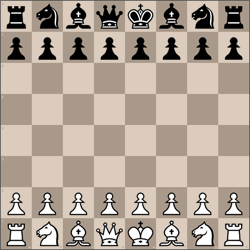February 28 1943
The Los Angeles Times, Los Angeles, California, Sunday, February 28, 1943
A King's Gambit
Alekhine and Keres met in the Salzburg Tournament played last year. In their first game, the young Esthonian succumbed to a Ruy Lopez. In their second, Keres needed to win to overtake the world's champion. His King's Gambit was bold, but Alekhine never faltered, and Keres never really had more than an outside chance.
Paul Keres vs Alexander Alekhine
Salzburg (1942), Salzburg AUT, rd 10, Jun-18
King's Gambit: Accepted. Schallop Defense (C34) 0-1
April 10 1943
April 11 1943
April 12 1943
April 13 1943
April 14 1943
April 15 1943
April 16 1943
April 17 1943
April 18 1943
April 19 1943
April 20 1943
April 21 1943
April 22 1943
April 23 1943
April 24 1943
April 25 1943
April 26 1943
April 27 1943
April 29 1943
May 24 1943
May 25 1943
May 26 1943
May 27 1943
June 09 1943
June 10 1943
June 11 1943
June 12 1943
June 13 1943
June 14 1943
June 15 1943
June 16 1943
June 17 1943
June 18 1943
July 20 1943
July 21 1943
July 22 1943
July 23 1943
July 25 1943
July 26 1943
July 27 1943
July 28 1943
September 05 1943
The Los Angeles Times, Los Angeles, California, Sunday, September 05, 1943
In a recent book, “Fifty Great Games of Modern Chess,” the author, H. Golombek, in discussing the youthful Paul Keres, the Estonian master, states the most impressive point in Keres' style is his power of producing dynamic attacks in much the same way as a conjuror produces a rabbit out of nothing. Golombek says Keres has played a vast number of games in which he breaks through the barrier of position play with a dazzling stream of fluid piece maneuvers. This game was played in the Semmering tournament of 1937, Keres' opponent being E. Eliskases.
Paul Keres vs Erich Eliskases
Semmering/Baden (1937), Semmering/Baden AUT, rd 5, Sep-14
Sicilian Defense: Wing Gambit. Deferred Variation (B50) 1-0
—A delayed Wing Gambit which, though formidable in the hands of an attacking genius such as Keres, has not really much sting.
(b)—Simple and sound is N-KB3; 4. PxP NxP; 5. PxP NxP(Q3)
(c)—It is wrong to open up the position here; best is P-KN3.
(d)—P-KR3 would be bad because of 9. N-K6.
(e)—Black must leave white in possession of the center since PxP e.p. fails against 10. Q-N5, P-K3; 11. NxBP KxN; 12. N-N5ch.
(f)—Too ambitious; preferable was P-N3, followed by B-N2
(g)—And here R-K1 was better than the text.
(h)—If QxP, then 20. N-B5 QxR; 21. QxP N-B4; 22. NxPch K-R1; 23. NxPch K-N1; 24. N-R6ch K-R1; 25. Q-R5 NxB; 26. N-B5 dis. ch, K-N1; 27. N-K7 mate.
(i)—A positional sacrifice of the highest order by white White takes full advantage of the weakness of Black's king side.
(j)—The threat was QxBch and N-B5ch.
(k)—Threatening 33. B-N4ch K-N1; 34. R-N5.
(l)—White's two bishops prove more powerful than Black's two rooks. If now Black plays NxR, then, 34. Q-Q8ch, R-K1; 35. B-N4ch, or if Black plays K-K1, then 34. R-R8ch N-N1; 35. B-N5ch and wins.
October 1943
October 04 1943
October 06 1943
October 07 1943
October 08 1943
October 10 1943
October 11 1943
October 12 1943
October 13 1943
October 15 1943
October 16 1943
October 17 1943
October 18 1943
October 20 1943
October 21 1943
October 25 1943
December 03 1943
December 08 1943
December 09 1943
December 18 1943


























